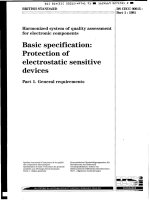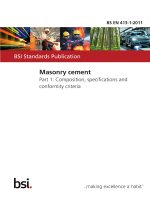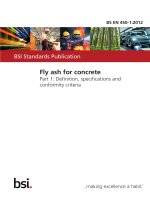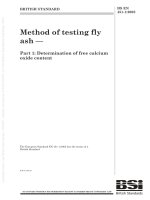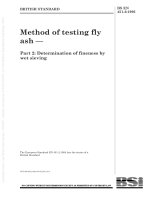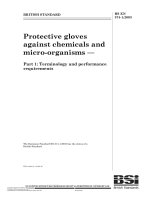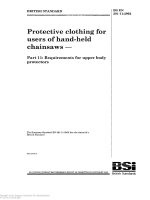Bsi bs en 10016 1 1995 scan
Bạn đang xem bản rút gọn của tài liệu. Xem và tải ngay bản đầy đủ của tài liệu tại đây (397.16 KB, 9 trang )
~
BRITISH STANDARD
Non-alloy steel rod for
drawing and/or cold
rolling
Part 1. General requirements
British Steel SP0
Standards-Section
Subject To Updating
ICS 77.140.70
BSEN
10016-1 : 1995
Ill
It
BS EN 10016-1: 1995
National foreword
o
This British Standard has been prepared by Technical Committee ISE/71 and is
the English language version of EN 10016-1 Non-alloy steel rod for drawing
and/or cold rolling Part 1: General requirements, published by the European
Committee for Standardization (CEN).
Cross-references
Publication referred to
Corresponding British Standard
EN 10002-1 : 1990
BS EN 10002 Tensile testing of metallic materials
Part 1: 1990 Method of test at ambient temperature
EN 10020: 1988
BS EN 10020 : 1991 Definition and classification of
grades of steel
EN 10021 : 1993
BS EN 10021: 1993 General technical delivery
requirements for steel and iron products
EN 10027-1 : 1992
EN 10027-2 : 1991
BS EN 10027 Designation systems for steel
Part 1 : 1992 Steel names, principal symbols
Part 2 : 1992 Steel numbers
EN 10052 : 1993
BS EN 10052 : 1994 Vocabulary of heat treatment
terms for ferrous products
EN 10079 : 1992
BS EN 10079 : 1993 Definition of steel products
EN 10204 : 1991
BS EN 10204 : 1991 Metallic products. Types of
inspection documents
EURONORM 17 : 1970
BS4956 : 1973 Specification for dimensions and
tolerances of hot rolled round steel rods for wire
drawing
EURONORM 104 : 1970
BS 6617 Determination of decarburization in steel
Part 1 : 1985 Methods for determining
decarburismtion by microscopic and micro-hardness
techniques
Part 2 : 1987 Methods for determining
decarburization by chemical and spectrographic
analysis techniques
Compliance with a British Standard does not of itself confer immunity from
legal obligations.
c
II
EN 10016-1
EUROPEAN STANDARD
o
NORME EUROPEENNE
EUROPAISCHE NORM
December 1994
ICS 77.140.70
Descriptors: Iron and steel products, unalloyed steels, wire drawing, cold rolling, wire rod, classifications, designation, specifications,
inspection, marking
English version
Non-alloy steel rod for drawing and/or cold rolling—
Part 1: General requirements
o
Fil machine en acier non allie destine au
treTilage et/ou laminage a froid —
Partie 1: Prescriptions generates
Walzdraht aus unlegiertem Stahl zum Ziehen
und/oder Kaltwalzen —
Teil 1: Allgemeine Anforderungen
This European Standard was approved by CEN on 1994-11-10. CEN members
are bound to comply with the CEN/CENELEC Internal Regulations which
stipulate the conditions for giving this European Standard the status of a
national standard without any alteration.
Up-to-date lists and bibliographical references concerning such national
standards may be obtained on application to the Central Secretariat or to any
CEN member.
This European Standard exists in three official versions (English, French,
German). A version in any other language made by translation under the
responsibility of a CEN member into its own language and notified to the
Central Secretariat has the same status as the official versions.
CEN members are the national standards bodies of Austria, Belgium,
Denmark, Finland, France, Germany, Greece, Iceland, Ireland, Italy,
Luxembourg, Netherlands, Norway, Portugal, Spain, Sweden, Switzerland and
United Kingdom.
CEN
European Committee for Standardization
Comite European de Normalisation
Europaisches Komitee fur Normung
Central Secretariat: rue de Stassart 36, B-1050 Brussels
C
© 1994 Copyright reserved to CEN members
Page 2
EN 10016-1 1994
Foreword
This European Standard EN 10016 is subdivided as
follows:
i
Contents
Foreword
1
Scope
- Part 1 :
General requirements
2 Normative references
- Part 2 :
Specific requirements far general
purpose rod
3
Definitions
- Part 3 :
Specific requirements for rimmed
4
Classification and designation
and rimmed substitute low carbon
5
Information to be supplied by the
steel rod
purchaser
- Part 4 :
Specific requirements for rod for
6
Production process
special applications
7
Requirements
i This European Standard has been drawn up
7.1 General
by ECISS/TC 15, Wire-rod - Qualities, dimensions,
7.2 Quality assurance
tolerances and specific tests, whose Secretariat is
held by UNI/UNSIDER.
7.3 Method of delivery
Part 1-2-3 and 4 of this European Standard replace: 7.4 Delivery condition
8
Dimensions, mass and tolerances
EURONORM
Non alloy steel wire rod for cold
9
Inspection
16(1987):
drawing and/or cold rolling
9.1 Inspection and inspection
This European Standard shall be given the status of
documents
a national standard, either by publication of an
9.2 Extension of inspection
identical text or by endorsement, at the latest
9.3 Acceptance unit and number of
by June 1995, and conflicting national standards
samples and test pieces
shall be withdrawn at the latest by June 1995.
According to the CEN/CENELEC Internal
9.4 Test of chemical composition
Regulations, the following countries are bound to
9.5 Test of decarburization, surface
implement this European Standard: Austria,
defects, non-metallic inclusions and
Belgium, Denmark, Finland, France, Germany,
core segregation
Greece, Iceland, Ireland, Italy, Luxembourg,
9.6 Test methods
Netherlands, Norway, Portugal, Spain, Sweden,
'Switzerland, United Kingdom.
9.7 Invalidation of tests
9.8 Retests
9.9 Sorting or reprocessing
10 Marking
11 Complaints after delivery
Annex A (normative) Determination of
core segregation
Page
2
3
3
3
3
4
4
4
4
4
4
4
4
4
4
4
5
5
5
5
5
5
5
5
5
6
C
Page3
EN 10016-1: 1994
0
1 Scope
EN 10027/1
1.1 This European Standard is applicable to rod of
non-alloy steel intended for wire drawing and/or
cold rolling. The cross-section of the rod may be
round, square, rectangular, hexagonal, half-round
or another shape and as a general rule of nominal
size 5 mm or above (see EURONORM 17) : the
surface is smooth.
1.2 It is not applicable to following products for
which standards exist or are under study such as:
- steel rod intended for heat treatment
(see EN 10083 and EURONORM 84, 85 and 86);
- rod of free-cutting steels (see EURONORM 87);
- steel rod for cold heading and cold extrusion
(see EURONORM 119);
- steel rod intended for the production of
electrodes and products for welding
(see EURONORM 133);
- steel rod for welded fabric for reinforcement
for concrete (see prENV 10080);
- steel rod for wire for high fatigue strength
mechanical springs, such as valve springs.
1.3 In addition to the requirements of this
standard the general technical delivery
requirements specified in EN 10021 apply.
2 Normative references
This European Standard incorporates by dated or
undated reference provisions from other
publications. These normative references are cited
at the appropriate places in the text and the
publications are listed hereafter. For dated
references, subsequent amendments to or revisions
of any of these publications apply to this European
Standard only when incorporated in it by
amendment or revision. For undated references the
latest edition of the publication referred to applies.
EN 10002/1
EURONORM
171)
EURONORM
181)
EN 10020
EN 10021
o
Metallic materials — Tensile
testing — Part 1 : Method of test
(at ambient temperature)
General purpose rod of non-alloy
steel for drawing — Dimensions
and tolerances
Selection and preparation of
samples and test pieces for steel and
iron and steel products
Definition and classification of
grades of steel
General technical delivery
requirements for steel and iron and
steel products
EN 10027/2
EN 10052
EN 10079
EURONORM
104( 1)
EN 10204
ECISS 1C 10
Designation systems for steel —
Part 1 : Steel names; principal
symbols
Designation systems for steel —
Part 2 : Steel numbers
Vocabulary of heat treatment terms
for ferrous products
Definition of steel products
Determination of the depth of
decarburization of non-alloy and
low alloy structural steels
Metallic products — Types of
inspection documents
Designation systems for steel —
Additional symbols for steel names
3 Definitions
For the purpose of this standard the following
definitions apply in addition to the definitions in
EU 18, EN 10020, EN 10021, EN 10052 and
EN 10079:
Heat analysis
A chemical analysis representative of the heat
determined by the steelmaker at his discretion in a
manner of his choice;
Product analysis
A chemical analysis carried out on a sample of the
delivered product.
4 Classification and designation
4.1 Classification
The classification of the steel grades covered by
this European Standard according to EN 10020 is
indicated in table 1 of EN 10016 Parts 2, 3 and 4
for the corresponding steel grades.
4.2 Designation
4.2.1 Steel names
For the steel grades covered by this European
Standard, the steel names as given in table 1 of
EN 10016 Parts 2, 3 and 4 are allocated in
accordance with EN 10027/1 and information
circular ECISS 1C 10.
4.2.2 Steel numbers
For the steel grades covered by this European
Standard the steel numbers as given in table 1 of
EN 10016 Parts 2, 3 and 4 are allocated in
accordance with EN 10027/2.
II
rage 4
EN 10016-1: 1994
It
o
7 Requirements
5 Information to be supplied by the
purchaser
The following information shall be supplied by the
purchaser at the time of enquiry and order, to
enable the supplier to comply satisfactorily with
the requirements of this European Standard:
a) quantity to be delivered;
b) product denomination (rod);
c) cross-section (round, square, hexagonal, etc);
d) reference to the dimensional standard EU 17;
e) nominal dimensions;
f) reference to this European Standard;
g) steel name or steel number (see 4.2);
h) dimensions and mass of coils;
i) surface condition (where different from the
as-rolled condition);
j) where applicable, indication of the type of
descaling (chemical or mechanical);
k) where applicable, the type of inspection and
inspection document in accordance with
EN 10021 and EN 10204 respectively (see 9.1);
1) where applicable, the method of binding and
labelling;
m) where applicable, if the steel grade shall be
suitable for galvanization;
n) where applicable, suitable for direct drawing;
o) where applicable, suitable for patenting.
6 Production process
The steelmaking and fabrication processes shall be
,made known to the purchaser. Those processes that
are specifically agreed shall not be changed
without prior agreement of the purchaser.
7.1 General
The manufacturer is responsible, using the means
he thinks fit, for inspecting his production from the
point of view of the various quality criteria
specified. In view of the fact that it is impossible in
practice to inspect coils of rod apart from at the
ends of the coils delivered, it cannot be proved
that no value greater than the specified limits is to
be found in the coil as a whole. Statistical
evaluation of performances applicable to all coils
may be agreed between the purchaser and the
manufacturer at the time of ordering.
7.2 Quality assurance
The products shall be supplied under a recognized
quality assurance system.
7.3 Method of delivery
The products shall be delivered by heat or part of a
heat. The number of heats per delivery shall be
minimized as far as possible.
7.4 Delivery condition
Rod shall be supplied in the as-rolled state, in coils
of one continuous length with non-aligned turns,
but capable of being unwound in a regular manner
during subsequent processing. The coils shall be cut
back at both ends to provide a product of uniform
shape and properties.
8 Dimensions, mass and tolerances
The dimensions, mass and tolerances of the
products shall be in accordance with the
requirements of EU 17.
9 Inspection
9.1 Inspection and inspection documents
The provisions of EN 10021 and EN 10204 shall
apply.
9.2 Extension of inspection
If the order is accompanied by a request for an
inspection certificate, the inspection shall be
carried out in accordance with table 1.
0
Table 1. Extension of inspection
Type of test
General purpose rod
(EN 10016-2)
Low carbon steel rod
(EN 10016-3)
Rod for special
applications (EN 10016-4)
Surface defects
Decarburization
Non-metallic inclusions
Core segregation
Product analysis
Tensile strength
0
0
0
0
0
+
+
-
+
0
0
0
0
+ - is carried out
- - is not carried out
0 - is only carried out if part of the options and/or is agreed at time of ordering
0
0
0
c
PageS
EN 10016-1: 1994
o
9.3 Acceptance unit and number of samples and
test pieces
The acceptance unit is composed of rod of the
same diameter or equivalent dimension, originating
from the same heat and rolled as a single
continuous lot unless otherwise agreed. If specific
inspection is required the number of test pieces
of table 2 shall apply; for rod for special wire
applications a higher frequency of sampling may be
agreed. If non-specific inspection is required the
performance statistics or suitable data may be
used.
9.4 lest of chemical composition
Where it has been agreed to verify the chemical
composition on the product, the samples shall be
taken and prepared in accordance with EU 18.
9.5 Test of decarburization, surface defects,
non-metallic inclusions and core segregation
9.5.1 For testing for surface defects, total
decarburization, non-metallic inclusions and core
segregation, the test pieces shall be taken from one
end of the cropped coil (see 7.4).
9.5.2 Testing for decarburization shall be carried
out on the rod in the as-rolled condition, in
accordance with EU 104 with the following
exceptions.
Decarburization is inspected by microscope on a
transverse metallographic test piece suitably
etched, with a magnification of x 200. The depth
of decarburization of the sample, is considered as
being the average of 8 measurements at the ends
of 4 diameters located at 45° to each other,
starting from the zone of maximum decarburization
and avoid starting from a defective zone. In the
calculation of the above average value, any
measuring point of the seven remaining situated in
a local surface defect shall not be taken into
account in the calculation.
9.5.3 For the determination of non-metallic
inclusions and core segregation, the tests shall be
carried out on the rod in the as-rolled condition
and in accordance with EN 10016 Part 2
(clause 3.4), EN 10016 Part 3 (clause 3.4), and
EN 10016 Part 4 (clauses 3.5 and 3.6).
9.6 lest methods
9.6.1 Test of chemical composition
The methods to be applied for the verification of
the product analysis shall be agreed at the time of
ordering, with reference to existing European
Standards, where these are available. For
arbitrational analyses, the methods shall be the
subject of agreement between the parties
concerned.
9.6.2 Test for surface defects
The method to be used for revealing surface
defects shall be chosen by the manufacturer.
9.6.3 Tensile test
The tensile test is carried out on rod in the
as-rolled condition, in accordance
with EN 10002/1.
9.6.4 Test for core segregation
The method for determining the core segregation
will be by macrographic examination on a
transverse section of the sample as detailed in the
annex A to this European Standard.
9.7 Invalidation of tests
See EN 10021.
9.8 Setests
See EN 10021.
9.9 Sorting or reprocessing
See EN 10021.
10 Marking
Each coil in each consignment shall be marked
with the following information:
- dimensions of the cross-section of the rod;
- designation of the steel grade;
- cast number;
- manufacturer's name and symbol;
- any subsequently agreed information.
The marking shall withstand pickling. The
durability of the labels utilized for marking shall be
agreed at the time of ordering.
11 Complaints after delivery
See EN 10021.
Table 2. Acceptance unit and number of samples and test pieces
IT;,
Type of requirement
Number of samples or test pieces
Product analysis
3, from 3 different coils originating from the same
heat, but not necessarily rolled as a single
continuous lot
Permissible depth of surface defects
Permissible depth of decarburization
Non-metallic inclusions
Tensile strength
1 for every 20 tons with a minimum of 3
II
It
Page 6
EN 10016-1: 1994
0
Annex
Annex A (normative) Determination of
core segregation
NOTE. The standard method which is outlined further is based
on the French standard NFA-04-114 and incorporates general
practise in Europe.
A.I Scope
This annex is applicable for rod made from
continuously cast steel with a carbon content of at
least 0,40 % C and defined in this European
Standard.
method described further is a macrographic
aimed at determining and evaluating the
core segregation present in continuously cast high
carbon rod by revealing the carbon segregation.
A. 2 Definition
For the purpose of this standard, the following
definition applies.
A. 2.1 Core segregation
Core segregation is the local variation in chemical
composition which can be noticed over a
cross-section of rod by macrographic examination.
It concerns primarily the segregation resulting from
the steelmaking process. This segregation takes
place concurrently for many elements: carbon,
phosphorus, manganese, sulfur, etc. This is the
reason why we can examine core segregation by
revealing specifically the carbon segregation. Grain
boundary cementite, which is particularly
influenced by the thermal history of the rod (from
"•mid steel to rod) and of its size can also cause
S^oblems in further processing. This justifies the
use of specific methods for evaluating the presence
of grain boundary cementite, which is related to
carbon segregation, but should not be confused
with core segregation.
A.3 Principle
The chemical heterogeneity is revealed by chemical
etching of a cross-section of the rod in a nital
solution. The images observed by macrographic
examination are compared with the pictures of the
reference chart and classified accordingly.
A.4 Preparation of samples
A. 4.1 Cutting
The surface to be examined is a transverse section
of each sample to be examined. This is obtained by
gradually cutting at low speed. In any case
excessive heating is to be avoided by appropriate
cooling.
A.4.2 Polishing
The sample is first polished stepwise, whereby the
finishing will be carried out with diamond paste of
final grain size 1 jtm. After mirror polishing the
sample is carefully washed with water and dried in
alcohol.
A.4.3 Etching
The polished surface is etched at ambient
temperature in the nital solution during
about 10 seconds. The nital solution is a solution
of 2 ml of nitric acid (20 =1,33 g/ml) in 100 ml of
ethanol. After etching the surface is dried in
alcohol.
A. 5 Evaluation of the segregation
The etched surface is observed with a binocular,
with illumination under a small angle with a
magnification so as to obtain about the same
dimension as for the reference pictures. The
pictures in the chart are limit references for each
class concerned. Actual pictures are compared,
positioned and graded within the reference chart.
They obtain the class of the reference picture equal
or worse than the picture under observation.
A.5.1 Classes of segregation
The reference chart presents 5 classes of
segregation.
Class 1 : without segregation zone
Class 2 : core segregation with slight contrast
(medium-grey)
Class 3 : core segregation with medium contrast
(dark-grey)
Class 4 : core segregation with pronounced contrast
(small black core)
Class 5 : core segregation with heavy contrast
(big black core).
A.5.2 Evaluation of the test results
It is generally accepted that a large number of
results is required for a statistically significant
evaluation of the core segregation of a cast or a
shipment. The value of the assessment of the core
segregation on an individual sample has only a
relative value. For this reason and for limiting the
number of tests to an economically acceptable level
it is advisable to use the determination of the
segregation as part of a quality assurance system.
C
Page 7
EN 10016-1: 1994

